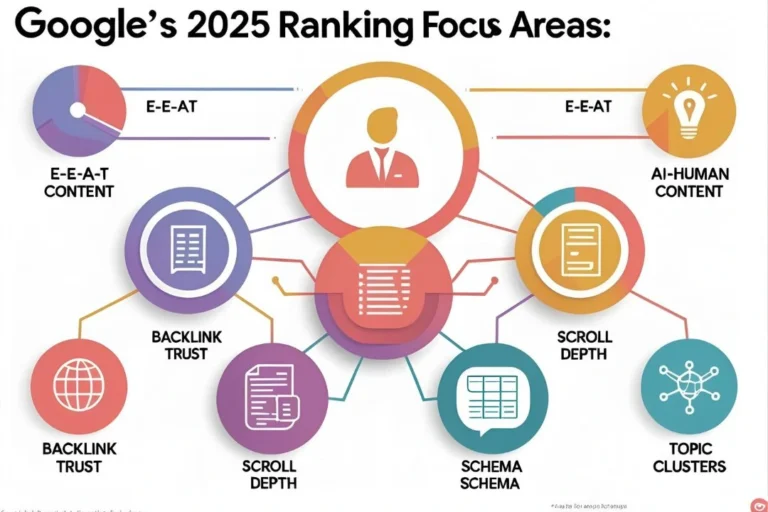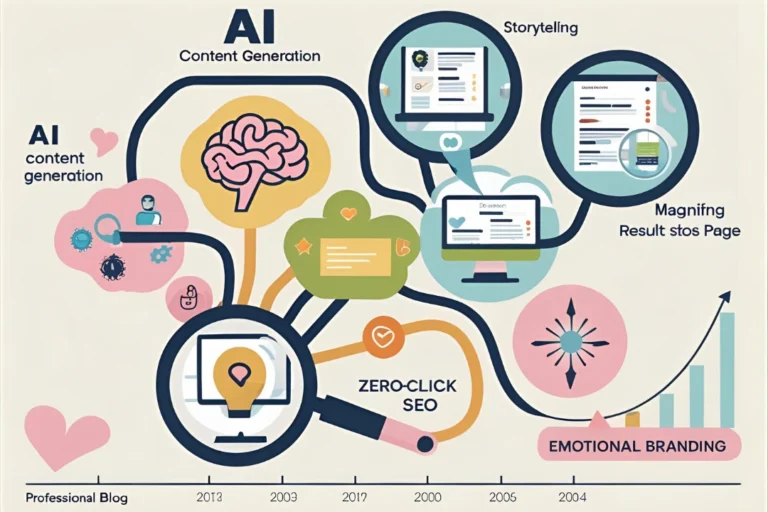This guide gives you 25 blog topic ideas across five major marketing categories (content, SEO, social media, email, and e-commerce), optimized for Google’s 2025 AI-driven SEO update. Each topic includes 50 NLP/LSI keywords and strategies to boost trust, dwell time, and authority.
Why This Matters in 2025?

Google’s latest algorithm focuses on:
Experience-based, original content
Trustworthy backlinks from relevant sources
User behavior signals like scroll depth and interaction
Verified authorship and topical authority
Balanced use of AI with human oversight
This article helps you align blog strategy with those expectations.
Content Marketing

1. Zero-Click Content: Mastering Visibility When Google Owns the SERP
Why: Google often answers queries without a click. This helps you still win visibility and authority.
Keywords: zero-click SEO, featured snippet optimization, no-click content strategy, Google position zero
2. AI-Human Co-Authoring Workflows That Google Can Trust
Why: AI writing needs human context and transparency to avoid penalization.
Keywords: AI content transparency, co-authored blogs, GPT-human integration
3. Case Study-Driven Topical Authority
Why: Real-world use cases build trust, E-E-A-T, and long-tail keyword strength.
Keywords: case study SEO, expert-backed content, topical depth
4. Content Experience vs. Consumption
Why: Google now measures how people interact with your content, not just if they click it.
Keywords: scroll behavior SEO, UX metrics, time on page
5. Thought Leadership Hubs: Own a Topic in 2025
Why: Cluster strategies boost topical authority and rankings.
Keywords: content clusters, evergreen blog structure, content hub
SEO (Search Engine Optimization)
6. Contextual Link Building in 2025
Why: Backlinks are judged more on context and credibility than quantity.
Keywords: contextual backlinks, link authority, trusted domains
7. Entity SEO: Google’s New Language
Why: Google now understands topics as entities, not strings.
Keywords: semantic SEO, entity recognition, Google knowledge graph
8. Mobile-First Means Experience-First
Why: Mobile UX is critical under Core Web Vitals and Page Experience.
Keywords: LCP, CLS, mobile indexing, CWV optimization
9. Voice Search & Conversational SEO
Why: Optimizing for Siri, Alexa, and voice bots captures new organic traffic.
Keywords: voice SEO, spoken keywords, conversational search
10. Scroll Tracking and Session Signals
Why: Scroll depth and engagement now impact SEO rankings.
Keywords: dwell time, content depth, user interaction metrics
Social Media Marketing
11. Co-Branding with Micro-Creators
Why: Collaborations generate trust-rich backlinks and social proof.
Keywords: influencer marketing SEO, UGC backlinks, verified mentions
12. Trendjacking with E-E-A-T
Why: Ride trends without sacrificing your credibility.
Keywords: trend marketing, ethical trendjacking, viral content trust
13. Social Proof SEO
Why: Testimonials, shares, and UGC boost your E-E-A-T.
Keywords: UGC SEO, branded social signals, engagement trust metrics
14. Indexable Social Content
Why: Repurpose social posts to boost search traffic.
Keywords: embedded social indexing, Instagram SEO, tweet schema
15. Human-First Campaigns Over Funnels
Why: Google prefers sustainable brand engagement, not short-term clickbait.
Keywords: digital community SEO, audience retention, authentic engagement
Email Marketing
16. Zero-Party Data in Email Marketing
Why: First-party and zero-party data now strengthen domain trust.
Keywords: consent-based email, privacy signals, zero-party SEO
17. Email Open Rates Affect SEO
Why: Google considers domain trust and user interaction via email too.
Keywords: email engagement signals, verified subscriber behavior
18. Post-Click Email Engagement
Why: What users do after clicking matters more than just the open.
Keywords: landing engagement SEO, post-email scroll metrics
19. Email + Social Sync
Why: Unified content across channels increases visibility and ranking.
Keywords: omnichannel strategy, cross-platform SEO, email pixel sync
20. Trust-Centered Email Design
Why: Natural, human-like emails improve interaction and engagement.
Keywords: interactive email elements, human mimicry in design, email UX
E-Commerce & Paid Media
21. Google-Preferred Product Pages
Why: Schema and experience metrics help rank e-commerce pages.
Keywords: ecommerce schema, structured product data, UX ratings
22. Shoppable Video SEO
Why: Google now indexes shoppable video content.
Keywords: video commerce, interactive ads, product video SEO
23. Micro-Reviews and UGC
Why: Small reviews build trust and add depth to product pages.
Keywords: micro-review schema, verified purchase comments
24. Humanized Product Descriptions
Why: Avoid thin or AI-only content penalties with human input.
Keywords: product storytelling, AI-proof copywriting
25. Optimizing for Voice Commerce
Why: Voice shopping is growing—optimize for voice triggers and commands.
Keywords: voice product search, voice-friendly pages, conversational UX



